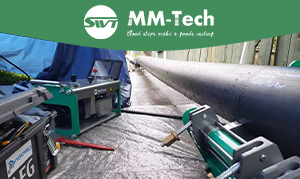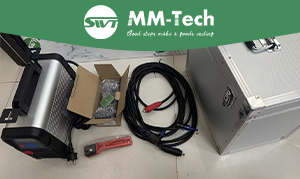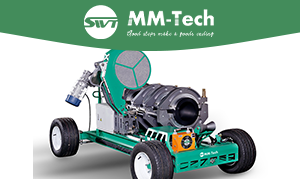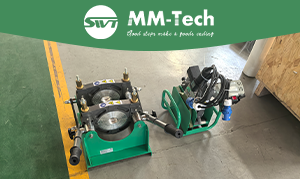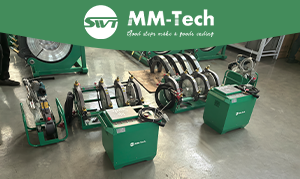Modern infrastructure relies heavily on durable piping systems to ensure uninterrupted water and gas supply. HDPE pipe fusion welding plays a crucial role in achieving this reliability. This method creates leak-free joints, enhancing efficiency and minimizing environmental impact. With the growing demand for sustainable construction practices, you need reliable tools like an HDPE pipe fusion welder to meet industry standards.
The environmental footprint of HDPE liner construction can be reduced by 70% compared to traditional methods, making it a preferred choice for green infrastructure projects.
This blog explores the top HDPE pipe fusion welders in 2025, helping you select the perfect equipment for your needs.
Key Takeaways
HDPE pipe fusion welding makes strong, leak-free connections. This improves water and gas system reliability.
Pick a fusion welder with strength, accuracy, and safety. These features help it last long and meet industry rules.
Automated welders lower mistakes and work faster. They are great for big construction projects.
Overview of HDPE Pipe Fusion Welding
What is HDPE Pipe Fusion Welding?
HDPE pipe fusion welding is a process that joins high-density polyethylene pipes by heating and melting their ends. This creates a seamless, leak-proof joint that matches the strength of the pipe itself. You can rely on this method for its durability and long-term performance in critical applications like water supply, gas distribution, and industrial systems.
There are two common techniques used in fusion welding:
Butt Fusion: This involves cleaning, aligning, heating, and pressing the pipe ends together.
Electrofusion: This uses fittings with embedded electrical coils to generate heat and fuse the pipes.
To achieve optimal results, you need specialized fusion equipment such as pipe welding machines, heating elements, and clamps. Following best practices, like keeping pipe ends clean and ensuring precise alignment, ensures reliable joints. Industry standards like ISO 21307 and ASTM F2620 guide the process, ensuring safety and quality.
Parameter | Value |
|---|---|
Melting Temperature (°C) | 131 |
Heating Temperature (°C) | 210 |
Cooling Time (Min) | 17 |
Welding Pressure (MPa) | 0.15 |
Benefits of HDPE Pipe Fusion Welding
Fusion welding offers several advantages that make it indispensable for modern infrastructure. The joints formed through this process are as strong as the pipe itself, eliminating weak points and reducing the risk of leaks. This ensures a longer service life for HDPE pipes, even under high mechanical and thermal stresses.
You’ll also appreciate the corrosion resistance of HDPE pipes, which minimizes maintenance and service interruptions. Their flexibility makes them ideal for earthquake-prone areas, as they can withstand ground movements without damage. Additionally, fusion welding eliminates the need for mechanical joints, which are common failure points in traditional systems.
Here are some key benefits:
Strong, durable joints enhance reliability.
Corrosion resistance reduces maintenance needs.
Flexibility ensures durability in challenging environments.
Leak-proof connections improve efficiency in critical applications.
By using a high-quality HDPE sheet welding machine, you can achieve these benefits while adhering to industry standards. This makes fusion welding a preferred choice for applications in construction, gas pipelines, and water systems.
Key Features to Look for in HDPE Pipe Fusion Welders
Durability and Build Quality
When selecting a pipe welding machine, durability and build quality should be your top priorities. Machines with robust frames and high-quality materials ensure long-term reliability, even in demanding environments. For example, HDPE pipe welding machines designed with corrosion-resistant components can withstand harsh conditions, reducing maintenance needs. This durability guarantees seamless welding and reliable performance over time.
Precision and Accuracy
Precision is critical in fusion welding. High-quality fusion welders offer advanced features like automated alignment systems and temperature controls to achieve welding precision. These features ensure consistent results, reducing the risk of joint failure. Whether you’re working on gas pipelines or water systems, precise welds enhance the overall efficiency and safety of your project.
Automation and Smart Features
Automatic pipe welding machines equipped with smart features simplify complex tasks. Automation reduces human error, while real-time monitoring optimizes welding parameters. For instance, machines with smart controls can adjust temperature and pressure automatically, ensuring high-quality joints. These features also improve efficiency, making them ideal for large-scale applications.
Feature | Description |
|---|---|
Automation | Robotics streamline the joining process, enhancing productivity. |
Smart Controls | Real-time data analysis optimizes welding parameters for consistent results. |
Portability and Ease of Use
Portable fusion welders are essential for on-site projects. Lightweight designs allow you to transport the machine easily, even to remote locations. Compact models simplify operation, making them suitable for smaller pipe sizes. For example, manual butt fusion machines are perfect for tight spaces and off-grid applications, offering reliable performance without compromising quality.
Safety Features
Safety features are non-negotiable in fusion welding. Machines compliant with standards like ASTM F2164 and ISO 12162 ensure resistance to stress and pressure. Features like insulated heating plates and protective frames minimize risks during operation. These safety measures not only protect operators but also enhance the durability of the welded joints.
Tip: Always check for compliance with industry standards to ensure the safety and reliability of your fusion welder.
Top HDPE Pipe Fusion Welders in 2025
MM-Tech Mazinger 1200i: Advanced Features and Applications
The MM-Tech Mazinger 1200i stands out as one of the most innovative HDPE pipe fusion welders available in 2025. Designed for demanding construction environments, this machine combines cutting-edge technology with user-friendly functionality to deliver exceptional results. Whether you’re working on gas pipelines, water supply systems, or large-scale infrastructure projects, the Mazinger 1200i offers unmatched reliability and performance.
Advanced Features That Set It Apart
The Mazinger 1200i boasts a range of advanced features that cater to both precision and efficiency. Its dual-axis structural frame ensures even force distribution during welding, which is critical for achieving high-quality joints. The machine’s SIEMENS PLC system automates the welding process, reducing the chances of human error and ensuring consistent results. This level of automation not only enhances precision but also saves valuable time on-site.
Another standout feature is the on-board heating plate, which comes with a protective frame and insulated shield. This design prioritizes operator safety while maintaining optimal heating performance. The hydraulic-powered high-capacity trimmer allows for precise pipe preparation, ensuring smooth and accurate cuts every time. Additionally, the removable chassis enables in-ditch usage, offering flexibility for various working conditions.
For professionals managing large-scale projects, the Mazinger 1200i provides robust data management capabilities. It can log up to 30,000 welding reports and supports USB data transfer, making it easy to track and analyze welding operations. This feature is particularly beneficial for manufacturers and distributors who require detailed records for quality assurance and compliance.
Feature | Description |
|---|---|
Dual-Axis Frame | Ensures even force distribution for superior joint quality. |
SIEMENS PLC System | Automates welding for precision and efficiency. |
On-Board Heating Plate | Includes a protective frame and insulated shield for enhanced safety. |
Hydraulic Trimmer | Delivers precise and efficient pipe preparation. |
Data Logging | Stores up to 30,000 reports with USB transfer for easy data management. |
Applications Across Industries
The versatility of the Mazinger 1200i makes it a valuable tool across multiple industries. Its ability to weld HDPE, polypropylene (PP), and polyvinylidene fluoride (PVDF) pipes within a range of 630 to 1200 mm (24″-48″ IPS) ensures compatibility with various project requirements. This flexibility makes it ideal for applications such as:
Gas Distribution: The machine’s precision and durability ensure leak-proof joints, critical for gas pipelines.
Water Supply Systems: Its corrosion-resistant welds guarantee long-lasting performance in water infrastructure.
Infrastructure Development: The Mazinger 1200i’s robust design handles the demands of large-scale construction projects.
The growing demand for HDPE pipe fusion welders reflects the increasing adoption of HDPE pipes in these industries. Market research projects the HDPE Pipe Butt Fusion Welding Machine market to reach $73 million by 2025, driven by a 7.1% CAGR from 2025 to 2033. This growth highlights the importance of reliable and efficient machines like the Mazinger 1200i in meeting industry needs.
Pro Tip: When selecting a fusion welder, consider its compatibility with your project’s pipe materials and sizes. Machines like the Mazinger 1200i offer the versatility needed for diverse applications.
Why Choose the Mazinger 1200i?
The Mazinger 1200i combines advanced features with practical design, making it a top choice for professionals. Its automation, safety measures, and data management capabilities streamline operations, while its robust construction ensures durability in challenging environments. By investing in this machine, you gain a reliable partner for your fusion welding needs, backed by MM-Tech’s commitment to quality and innovation.
Detailed Reviews of Top HDPE Pipe Fusion Welders
MM-Tech Mazinger 1200i: Technical Specifications and Industry Standards
The MM-Tech Mazinger 1200i sets a benchmark for HDPE pipe fusion welders with its advanced design and robust performance. This machine combines cutting-edge technology with practical features to meet the demands of modern infrastructure projects. Whether you’re working on gas pipelines or water systems, the Mazinger 1200i delivers precision and reliability.
Technical Specifications That Define Excellence
The Mazinger 1200i offers a welding range of 630 to 1200 mm (24″-48″ IPS), making it suitable for large-scale applications. Its dual-axis structural frame ensures even force distribution, which is essential for creating strong and durable joints. The machine operates with a SIEMENS PLC system, automating the welding process for consistent results. This automation reduces manual intervention, allowing you to focus on other critical aspects of your project.
The on-board heating plate features a protective frame and insulated shield, prioritizing operator safety while maintaining optimal heating performance. The hydraulic-powered trimmer ensures precise pipe preparation, which is crucial for achieving high-quality welds. Additionally, the removable chassis allows for in-ditch usage, offering flexibility in challenging environments.
Specification | Details |
|---|---|
Welding Range | 630 to 1200 mm (24″-48″ IPS) |
Structural Frame | Dual-axis design for even force distribution |
Automation System | SIEMENS PLC for precision and efficiency |
Heating Plate | Protective frame with insulated shield |
Data Logging Capacity | Up to 30,000 reports with USB transfer |
Industry Standards That Ensure Reliability
The Mazinger 1200i adheres to stringent industry standards, including ISO21307 and ASTM F2620. These standards guarantee the machine’s ability to produce welds that meet global quality benchmarks. By using this welder, you ensure compliance with safety and performance requirements, which is critical for infrastructure projects.
The machine’s design also incorporates features that align with ASTM F2164 and ISO 12162, ensuring resistance to stress and pressure. These standards enhance the durability of welded joints, making them suitable for high-pressure applications. You can trust the Mazinger 1200i to deliver results that exceed expectations.
Why It Stands Out Among HDPE Pipe Fusion Welders
The Mazinger 1200i excels in versatility, precision, and safety. Its ability to weld HDPE, polypropylene (PP), and polyvinylidene fluoride (PVDF) pipes makes it a valuable tool across industries. The machine’s advanced features, such as automated controls and data logging, streamline operations and improve efficiency. Its robust construction ensures durability, even in demanding environments.
If you’re looking for a reliable HDPE pipe fusion welder, the Mazinger 1200i offers unmatched performance and ease of use. Its compliance with industry standards and innovative features make it a top choice for professionals.
Tip: Always evaluate the technical specifications and industry standards of a fusion welder to ensure it meets your project requirements.
How to Choose the Right HDPE Pipe Fusion Welder
Factors to Consider Based on User Needs
Choosing the right HDPE pipe welding machine depends on your specific project requirements. Factors like project scale, budget, and operator expertise play a significant role in determining the best fit. Understanding these criteria ensures you get the most value from your investment.
Criteria | Manual Machines | Automatic Machines |
|---|---|---|
Project Scale | Cost-effective for smaller projects | Ideal for large-scale installations |
Budget | Lower upfront costs | Higher initial costs but lower labor expenses |
Operator Expertise | Requires skilled operators | Reduces reliance on operator skill |
Efficiency Requirements | Slower throughput | Increased productivity due to faster operation |
Mandatory Project Requirements | May not meet certification needs | Often required for public utility projects |
For smaller projects, manual machines offer a cost-effective solution. However, automatic machines provide greater efficiency and precision, making them ideal for large-scale pipeline construction. If your project involves strict certification requirements, automatic machines are often the better choice.
Choosing the right HDPE pipe fusion welder ensures strong, reliable joints for your projects. The Mazinger 1200i from MM-Tech stands out with its advanced automation, safety features, and precision. Evaluate your project’s scale, budget, and material needs to select the best equipment. A well-informed choice guarantees efficiency and long-term performance.
FAQ
What is the ideal pipe size range for HDPE fusion welders like the Mazinger 1200i?
The Mazinger 1200i handles pipe sizes from 630 to 1200 mm. This range suits large-scale projects like gas pipelines and water systems.
How does automation improve the welding process?
Automation ensures consistent temperature and pressure during welding. It reduces human error and speeds up operations, making it ideal for complex infrastructure projects.
Can HDPE fusion welders be used in confined spaces?
Yes, portable models like the Mazinger 1200i feature removable chassis for in-ditch usage. This flexibility makes them suitable for tight or challenging environments.


